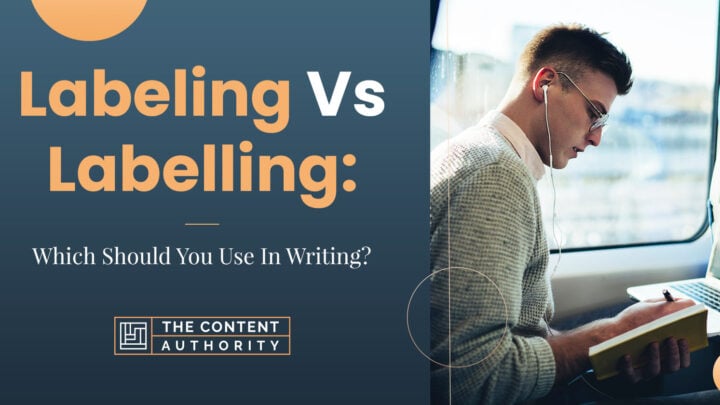Labeling vs. labelling; which of the two words is the correct spelling for the present participle of the word “label?” Well, this is a common question among English speakers because the only visible difference between the two words is the additional “l” in the second term. An overview of “labeling” and “labelling” is the best way to understand these two words.
Labeling is the present participle of “label.” It refers to a set of labels applied to objects in a system of introducing traceable chemical groups in biochemistry. Also, it refers to the process of attaching labels to something. In contrast, labelling is the UK alternative spelling for labeling.
Most sources, including blogs and dictionaries, describe labeling as the alternative form for labelling. However, this does not clarify the confusion between these two words. We have come up with this article to provide a comprehensive look into these words. Here we go!

Definitions Of Labeling And Labelling
Labelling and label are present participle forms for the word “label.” Therefore, starting this section by defining the word label would make sense.
A “label” is a small ticket or sign that provides information about a product or an object. It is usually attached to the object. For example, “Supermarkets attach price labels on their products.”
Another meaning for a label “is a name given to something or someone to categorize them as a member of a specific social group or show their association with a particular character.” For example, “She earned the label “criminal” because of her involvement with lawbreakers.”
As a verb, “label” means “to put a sign or sticker on an object.” Another meaning is “to give a label to someone or something because of their association with a social group or a character.” For example, in a sentence, “They went on to label her a criminal despite the lack of evidence.”
The definitions for “labelling” and “labeling” feature the word “label.” So, now that you understand the meaning of “label,” the definitions below should be easy to comprehend.
Definition Of Labeling
Labeling is the process of applying labels to various objects in a system. For example, “System labeling helps with data analysis.”
In Biochemistry, labeling refers to introducing traceable chemical groups into a protein or biomolecules so you can track or quantify it during experimental analysis. For example, in a sentence, “Labeling is a critical element during our incoming experimental research.”
Further, labeling is the present participle of “label.” You can form present participles in English by adding the suffix “-ing” to verbs. For instance, the present participle for “laugh” is “laughing,” and “label” is “labeling.”
Definition Of Labelling
Labelling is the UK alternative form of “labeling.” This implies that the two words share the exact definition but have different spellings. Also, like labeling, labelling is the present participle for “label.”
For instance, labelling refers to the process of attaching descriptive words or phrases to someone or something. In a sentence, “The public loves labelling people as criminals, even without evidence.”
Also, labelling means attaching informative stickers to objects. For example, in a sentence, “The storekeeper has finished labelling the new stock.”
How To Properly Use Labeling And Labelling In A Sentence
The key to mastering how to use English words in sentences is learning the contexts in which they apply. Note that their meanings usually define the contexts in which you can use the words. Therefore, with the information in the above definitions section, using these words in sentences should be easy. Here are some other things you should know when using these words in sentences:
How And When To Use Labeling
Use this word as a noun when referring to a set of labels applied to objects in a system. As a noun, this word can serve as your sentence’s subject or object. For example, “The labeling system for the project is faulty.”
Labeling is a present participle. Therefore, you can use it as an adjective or verb in a sentence. For instance, in a sentence, “We finished labeling the samples in the lab this morning.” In this sentence, “labeling” is the verb.
Another example is, “The labeling pencil has run out of ink.” In this example, “labeling” is an adjective because it tells more about the noun, the “pencil.”
How And When To Use Labelling
Since the definitions for labeling and labelling are similar, their applications are also the same. For instance, you can use this word as a present participle for “label.” In a sentence, “The students started labelling the samples before the experiment.”
Also, you can use it as a noun. For example, “The labelling system in the lab is faulty.” However, it would be wise to understand that labelling applies in the UK or British English. The same applies to countries that follow the British accent.
Labeling vs. Labelling: Pronunciation And Spelling Explained
The difference between labeling and labelling is the spelling. One word has a double letter “l” while the other has one. The first spelling is common in American English, while the second in British English.
That means you should use the first spelling “labeling” when writing in American English or targeting an American audience. In contrast, you should use the second spelling, “labelling,” in British or UK English or when targeting a British audience. This is consistent with several UK and American English words, like travelled (UK) and traveled (American).
For example, in sentences:
- The students labelled their books as they travelled to school. (UK/British English)
- The students labeled their books as they traveled to school. (American/US English)
The correct pronunciation for labeling is “/leɪ-blɪŋ/.” In contrast, since “labelling” is a UK spelling, its pronunciation is also British; its pitch and tonation differ from “labeling.” The correct pronunciation for labelling is “/lā-bəl-in./.”

Examples Of Labeling And Labelling Use In Sentences
Labeling and labelling are both correct English words. However, their spellings differ because one applies in American English and the other in British or UK English. Below are sentence examples featuring these words:
Example sentences of labeling
- The students finished labeling the class doors before the new students came in to the digital media lab.
- The school hires extra staff for classroom labeling at the beginning of every academic year.
- Labeling samples in the lab helps prevent misuse and promotes safety.
- The mistake resulted from the faulty labeling system and not the experimentalists.
- Labeling GMO content is not required because the subject is controversial and complex.
Example sentences of labelling
- It would help if you did not underestimate the value of labelling in ghost writing.
- We will be labelling this sentence as an opinion in the final article draft.
- Labelling the samples in your research will help you with tracking and final data analysis.
- The vandals travelled from England to Rome, labelling prominent buildings with graffiti.
- The students spent most of the morning labelling their new textbooks instead of revising them for the test.
Conclusion
Labelling and labeling are both acceptable words for the present participle of “label.” However, the spelling with a double “ll” is the UK alternative, unlike the one with a single “l.” Whether either word is correct or not depends on the type of English you want to use in writing. Note that if you choose the American spelling, the rest of your writing should also feature American spellings and vice versa.
A common mistake people make in writing is combining the UK and American spellings. While many get away with this mistake in informal writing, formal writing requires you to be audience conscious. What other words similar to ‘labeling” and “labelling” confuse you?
Shawn Manaher is the founder and CEO of The Content Authority. He’s one part content manager, one part writing ninja organizer, and two parts leader of top content creators. You don’t even want to know what he calls pancakes.

